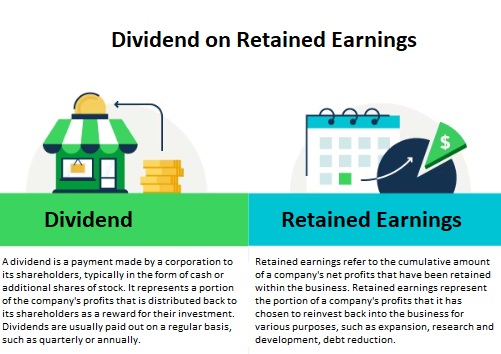Contents
- 1 What Are Retained Earnings?
- 2 Factors Influencing the Calculation of Retained Earnings
What Are Retained Earnings?
In the blog, we will be discussing how to calculate retained earnings with perfect examples.
Retained earnings vs net income: Retained earnings is the amount of net income left over for the business after it has paid out dividends to its shareholders.
The retained earnings surge whenever your business makes a profit and plunge each time you withdraw some from these profits as dividend payout.
Or
Retained earnings are net earnings that are not distributed to shareholders and that the company decides to reinvest. Since retained earnings has no connection to net-cash flow, it does not appear on the cash flow statement.
Many companies turn to retained earnings as a way of financing the company, as it is an effective way to avoid the outflow of money and having to resort to new obligations (that is, more indebtedness).
On the other hand, your net income is the amount left at the end of the month or year after deducting your operating expenses from revenue.
Factors Influencing the Calculation of Retained Earnings
Certainly, it seems you’re looking for an explanation of the factors that contribute to the calculation of retained earnings.
Here’s the information presented in a bullet-point format:
- Net Income or Net Loss:
Positive net income adds to retained earnings.
Negative net income (net loss) subtracts from retained earnings. - Dividend Payments:
Dividends paid to shareholders reduce retained earnings.
Higher dividends result in lower retained earnings. - Reinvestment in the Business:
Profits retained for reinvestment increase retained earnings.
Reinvesting in growth initiatives boosts retained earnings. - Economic Conditions:
Prosperous economic times increase profits and retained earnings.
Economic downturns lead to lower profits and decreased retained earnings. - Operational Efficiency:
Efficient operations increase net income and retained earnings.
Streamlined processes contribute to higher retained earnings. - Debt and Interest Expenses:
Interest payments on debt decrease net income and retained earnings.
Managing debt impacts the level of retained earnings. - Taxation Policies:
Tax changes affect net income and retained earnings.
Taxation impacts the company’s ability to accumulate retained earnings. - Industry and Competition:
Industry challenges can reduce profit margins and retained earnings.
Effective industry navigation supports healthy retained earnings. - Profitable Growth Strategies:
Successful expansion efforts contribute to higher net income and retained earnings.
Investment in innovation and new markets impacts retained earnings positively. - Share Buybacks:
Companies buying back their own shares reduce the number of outstanding shares.
This can lead to increased earnings per share and potentially higher retained earnings. - Legal and Regulatory Factors:
Compliance costs and legal fines impact net income and retained earnings.
Adhering to regulations preserves retained earnings. - Accounting Changes:
Changes in accounting methods can influence reported net income and, consequently, retained earnings. - Market Performance:
Fluctuations in asset values and investments affect overall profits and retained earnings. - Capital Expenditures:
Investments in capital assets impact net income and retained earnings.
Strategic spending influences the accumulation of retained earnings.
How To Calculate Retained Earnings?
The formula used to calculate retained earnings is quite simple. Adding the current retained earnings with profit/loss and subtracting the amount from dividends are your business’s retained earnings.
The retained earnings are those net earnings that the company is not distributed among shareholders, and has decided to reinvest in the company, in order to achieve growth in the company.
These profits can be used to increase the workforce, improve the budgets dedicated to research, have greater liquidity, prevent the outflow of money, cancel financial debts, etc.
With them, it is achieved that a company can finance itself, so that it does not have to apply for financial loans and be able to save the cost of interest.
In order to calculate this type of profit , expenses will have to be subtracted from total income, in addition to removing the part that corresponds to the distribution of dividends.
How to Find Retained Earnings?
| Retained Earnings Formula: Current Retained Earnings + Profit/Loss – Dividends |
The online accounting software will calculate the retained earnings when it generates a statement of retained earnings, balance sheet, and other financial statements of your business. If you are manually calculating your retained earnings, you will be required to figure out the three variables mentioned below before applying them to the above retained earnings formula:
- Your starting or present retained earnings, which is the amount with which your retained earnings balance has finished since the last time you calculate your retained earnings. In case you maintain a balance sheet every month, you need to work with the previous month’s retained earnings.
- Net profit/net loss will mainly be extracted from the income statement for the current accounting period. In case you generate the same on a monthly basis, use the current month’s net income or net loss to calculate retained earnings.
- Dividends which you distributed at present are fetched from the company’s profit and the shareholders decide to bring it out of the company. Whenever you decide to issue a cash dividend, every shareholder gets paid in cash. The more the shareholders have, the merrier the value of their dividend shares.
You May Also Read: How to calculate gross profit margin?

Save Time and Money with eBetterBooks Accounting
Drop us a line today for a free quote! Try It Now
Statement of Retained Earnings Example
Let us assume that your company started on February 1, 2020. That time your retained earnings balance will read $0, as you have no earnings to include.
Suppose we assume that your earnings for January are $2000 in net income per your income statement and without any issuance of dividends. That complies that on March 1, retained earnings of your company will be $2000.
If we put the above values in the retained earnings equation, we derive:
How to Calculate Retained earnings? = Current retained earnings + Net Income – Dividends
$0 + $2000 – $0 = $2000
*You earned $2000 and retained all of them which becomes your retained earnings.
Suggested Blogs:
What is an income statement? (Definition and Examples)
How to Calculate Cash Flow: 3 cash flow formulas with examples
Calculate The Effect Of A Dividend On Retained Earnings

At times, the company wishes to reward its shareholders with a dividend but without giving any cash away. They issue it in the form of a stock dividend, which is the dividend payment but made in shares rather than in cash.
Retained earnings equation after a stock dividend issuance, retained earnings calculation comprises additional steps to figure out the number of dividends you end up distributing.
You need to figure out the shares’ FMV (Fair Market Value) before distributing them.
Then, figure out the number of shares you have to give which should not be above a certain percentage of the company’s equity, as the company usually issues a percentage of their stock as a dividend.
How Do You Calculate Retained Earnings on A Balance Sheet?
Let us assume that in April, your business continues progressing along, and you make another profit of $20,000. As you put thought into keeping that money for future reinvestment in the industry, you waive cash dividend and, preferably, plans to issue a 5% stock dividend on the alternate side.
Now, if we assume that the company yours’s has a total of 15,000 outstanding shares of common stock, and as per your determination, the FMV stands at $10 for each share. This means that you would issue 100 shares in the dividend, and the reduced retained earning for every share counts at $10:
Current retained earnings + Net Income – (No. of shares x FMV of each share) = Retained earnings
$17,000 + $20,000 – (100 x $10) = $27,000
*On May 1, your retained earnings $27,000 for the business.
You may also read: How to View Journal Entries in QuickBooks Online
ABOUT: Working Capital and Stockholders Equity
However, all that has to be concerned is with the equity section of the working capital, balance sheet, and shareholders equity that are varied from retained earnings. Owners’ equity accounts for the company’s worth in case you decide to dissolve all the assets. Permanent accounts aggregated into the balance sheet can be assets, equity accounts or liabilities. In the case of a Nonprofit entity, it can be a liability, asset or net asset account.
(how to calculate retained earnings with assets and liabilities?)
Total Assets – Total Liabilities = Stockholders Equity
Resources that your small business enterprise has at its disposal to bear daily operations are referred to as your business’s working capital. The accounting equation for calculating the working capital is:
Current Assets – Current Liabilities = Working Capital
Conclusion:
Within the balance sheet, these retained earnings will be reflected within the company’s equity.
They will be calculated at the end of an accounting period, and an increase or decrease in them will be the result of the net income and dividends paid in that period. Finally, it should be noted that they will provide a financial mechanism that will be crucial for a company to enjoy good health.
We hope this blog was informative enough to end your issues and queries about your company’s retained earnings equation and what is included in retained earnings. Keeping track of your companies’ financial health is vital; calculating your company’s total profit and revenue will support the business in the long run for commercial success.
Related Post:






